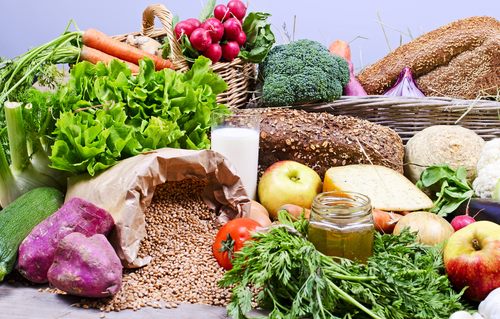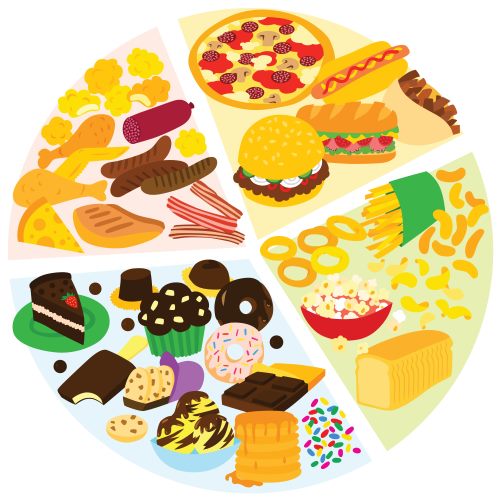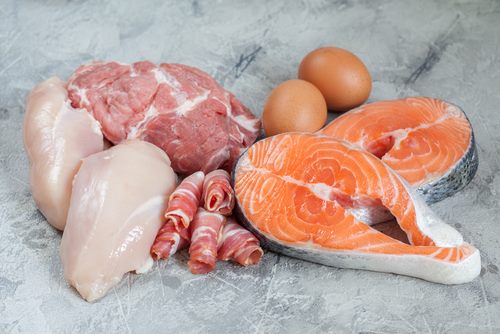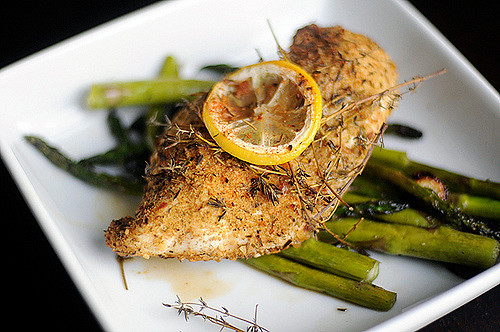Clean Eating Food List That Helps With Weight Loss
THIS POST MAY CONTAIN AFFILIATE LINKS. PLEASE SEE OUR FULL DISCLOSURE POLICY FOR DETAILS.
Clean eating isn’t boring. You will be surprised at the number of mouth-watering recipes available on the internet using these clean foods.
If you’re interested in clean eating, it’s likely that you wonder what types of food you’ll be able to enjoy once you rid your pantry and cupboards of all the junk. Great news: The clean eating food list is a very long one, with delicious ingredients that you can use to make meals, snacks, and even fantastic desserts. Besides a list of more than 300 clean foods plus snack ideas to prevent you from caving in to the vending machine’s beckoning glow, you’ll find handy tips for clean eating – all designed to help you succeed in your quest for better health, naturally.
You might also be interested in our Kosher food list for more dietary guidelines.
If you’re following a clean eating plan, then grab the Clutter Keeper Meal Planner to keep yourself organized. You can track your favorite recipes and write out your grocery lists, and more!
Benefits of a Clean Eating Program

Clean eating isn’t a diet; instead, it’s a lifestyle. With an emphasis on whole foods including meats, fish, dairy products, grains, vegetables, and fruits, it offers benefits for omnivores, pescatarians, vegetarians, and vegans alike. Whatever your preferences, you’ll find that clean eating treats you to the best nutrition possible. Depending on your food choices and other lifestyle changes such as the addition of exercise, you are likely to enjoy some or all of the following clean eating benefits:
- Ability to enjoy a wide variety of foods
- Reduced exposure to environmental toxins present in processed foods
- Improved cardiac health
- Reduced risk of cancer
- Lower risk of diabetes
- Reduced risk of Alzheimer’s disease
- Lower risk of stroke
- Better nutrition
- Weight loss
- Healthier teeth and gums
- Glowing skin
- Stronger, shinier hair
- Healthy nails
- Less hunger
- No more sugar cravings
- Better organ function
- Improved mood
- Better sleep
- Greater sense of self-awareness
Some people take clean eating to the extreme and forgo all packaged foods, even those which have only been slightly processed. Others simply avoid highly processed items that contain chemical additives such as preservatives, artificial colors, artificial flavors, trans fats, and other unhealthy additions like added salt, added sugar, and high-fructose corn syrup. Some give up caffeine and all forms of alcohol, while others opt to embrace them in moderation. The choices are yours to make; for example, you might decide to eat completely clean six days per week and cheat a bit on the seventh day. In the end, the more often you embrace clean eating, the more you are likely to benefit – but even moderate changes will lead to improved health.
Clean Eating Food List: Foods to Avoid

A big part of clean eating is a general knowledge of what to avoid. Most people spend extra time food shopping in the beginning, as they read labels in an effort to ferret out hidden additives. If you follow the general clean eating rule of “no processed foods” then you’ll find that this part is pretty easy. Some common foods and ingredients to avoid follow.
- According to Organic 4 Green Livings health blogger Maria Valetudo, anything unpronounceable; if you don’t understand what an ingredient is, it probably isn’t part of your clean eating food list!
- Canned foods with lots of ingredients such as soups, pastas, pie fillings, etc.
- Foods in cans with liners that contain BPA (bisphenol acetate)
- Water and other beverages bottled in containers made with BPA
- Frozen convenience foods such as pizza, lasagna, pierogi, etc.
- Bakery items like bread, donuts, cakes, and pies (Don’t worry – you can make your own with healthy ingredients.)
- Anything containing white flour or white sugar
- Items containing high-fructose corn syrup and other forms of concentrated sugar
- Artificial sweeteners of any type
- Trans-fats and highly processed fats
- Packaged snacks such as potato chips, pretzels, flavored popcorn, etc.
- Candy
- Soda
- Processed meats like bacon, sausage, ham, etc.
- Processed cheeses and other dairy products that contain additives
- Foods containing harmful processed fats such as hydrogenated vegetable oil and partially-hydrogenated vegetable oil.
Last but certainly not least, you’ll want to avoid genetically modified foods in countries where they are still permitted. In the United States, look for Non-GMO Project labels when purchasing packaged foods. The Non-GMO Project Verified program is growing by leaps and bounds, so it is possible to find a vast variety of certified foods including corn and soy products. Be sure to check dairy, eggs, and meat for Non-GMO project labeling; besides buying organic, it’s a good way to ensure that you are keeping genetically modified animal feeds out of your own food chain. The Non-GMO Project website and its partner site, Living Non-GMO, are two excellent, trustworthy sources of information on genetically engineered produce, fish, and more. It’s a good idea to visit regularly to view updates.
Clean Eating Food List: Foods to Enjoy
Use this clean eating food list as a tool for making better choices at every meal. Whether you ease your way into your new lifestyle or jump into clean eating head first, you’ll notice that you feel and look better quickly. Note that clean eating emphasizes local, organic foods when and where they are available. These are generally fresher and more nutritious, but don’t overlook whole frozen and jarred foods, which are often higher in vitamins than fresh versions which have been trucked long distances and kept in cold storage for extensive periods of time. As you decide which foods to eat, keep simplicity and nutrient density in mind. Of course, if you’re on a specific diet – like keto – you’ll need to work out which of the following foods fit into your meal plan.
Meat, Poultry, and Eggs

Most supermarket meats do not meet clean eating standards, as the majority of livestock and poultry raised in filthy confined animal feeding operations (CAFOs) are fed diets consisting mainly of genetically modified corn and soy, not to mention unsavory byproducts from industrial food processors. Many have antibiotics added to their feed, which in turn enter your system and create resistance to antibiotics, creating a barrier to healing in the event you have an infection and require antibiotic therapy.
If you are able to hunt, you can easily fill your freezer with wild game. Be sure to take appropriate hunters’ safety classes and purchase the necessary permits, and ensure that you are respectful of the game and the land that it comes from. Taking wild game gives you the opportunity to reflect on the value of a clean environment, and eating it provides you with excellent nutrition as well as a sense of accomplishment.
If you live in a community where backyard chickens are permitted, you can raise a few hens, feed them a clean, organic diet, and save money on eggs from healthy, happy chickens that will quickly feel like part of the family.
Besides hunting for your own meat and raising your own chickens for their eggs, local organic farmers are the best sources for meat, poultry, and eggs. Trustworthy farmers often allow and even encourage visitors, and many sell their products in bulk. You will save money if you purchase a share in a grass-fed steer instead of buying meat by individual cut, for example.
- Antelope
- Bacon, organic uncured varieties
- Beef
- Beefalo
- Buffalo
- Caribou
- Chicken
- Duck
- Elk
- Emu
- Goat
- Goose
- Ham, organic uncured varieties
- Hot dogs, organic uncured varieties
- Hare
- Lamb
- Lunch eat, organic uncured varieties
- Moose
- Mountain goat
- Mountain sheep
- Mutton
- Ostrich
- Partridge
- Pheasant
- Pork
- Quail
- Rabbit
- Sausage, organic, uncured varieties
- Turkey
- Venison
- Water buffalo
Fish and Seafood

Once, before industrial pollution, all fish and seafood was safe to eat. Today, most varieties are loaded with contaminants – even trout from certain local streams should be avoided over concern about contact with industrial runoff. Frozen fish and seafood is often superior to fresh; it’s flash frozen immediately after being cleaned, and it is often less costly.
Be sure to avoid farmed fish and shellfish, as these are typically fed substandard diets and kept in dirty conditions. Wild-caught fish and shellfish from certified, responsible sources are best. Look for the blue Marine Stewardship Council label: it’s a good sign that the fish you are purchasing is sustainable and safe. Ensure that your choices are not processed with added sodium solutions, breading, marinades, and other additions. You’ll be able to create your own recipes with whole, clean foods from your pantry.
Finally, be certain to avoid or limit fish from the top of the food chain. Predators with long lives absorb more toxins from the animals they eat, as well as from the environment. Examples include filefish, swordfish, marlin, king mackerel, ahi tuna, bigeye, and shark. Never eat marine mammals, turtles, or seabirds, as they tend to have high levels of toxins.
- Anchovies
- Albacore tuna, no salt added
- Clams
- Cockles
- Cod
- Crab
- Dogfish
- Flounder
- Haddock
- Hake
- Halibut
- Herring
- Hoki
- Krill
- Lobster
- Lumpfish
- Mackerel
- Mussels
- Oysters
- Pike-perch
- Plaice
- Pollock
- Prawns
- Razor shell clams
- Sablefish
- Saithe
- Salmon
- Sardines
- Scallops
- Shrimp
- Toothfish
- Trout
- Tuna
- Whiting
Dairy
Like most commercial beef products, most commercial dairy products come from cattle fed a heavy diet of genetically modified corn, soy, and industrial byproducts – and kept in almost unbelievably filthy conditions. The good news is that farmers are recognizing and responding to the increased demand for grass-fed dairy products, and local, artisanal dairies are popping up in many communities. Pasteurized, unhomogenized dairy products are available at many dairies as well as at local stores and farmers’ markets. Expect to pay a premium price, but be prepared to thoroughly enjoy these superior products if you can get them. Supporting these farmers encourages better animal husbandry and bolsters local farmers who enjoy serving appreciative clients.
If you can’t find a local dairy or buy a cow and care for her yourself, perhaps you can buy into a cow share – some small farmers offer these, providing their customers with access to raw, unhomogenized milk from which a vast variety of products can be made. Raw dairy and cow shares are a touchy subject as they’re illegal in many places. You can, of course pasteurize milk yourself once it arrives home!
- Cream
- Homemade ice cream with natural ingredients
- Milk (cow, goat, or sheep), preferably whole, unhomogenized
- Natural cheeses, all types
- Natural goat cheese
- Natural sheep’s cheese
- Natural yogurt with live, active cultures; preferably plain
Whole Grains
Whole grains make a heart-healthy addition to any meal or snack, and they reduce your risk for developing colorectal cancer and type 2 diabetes. Be absolutely certain that packages or bulk bins state that contents are “whole grain.” Marketing buzzwords to watch out for include multi-grain, stone-ground, and 100% wheat. These are sneaky attempts to confuse consumers into thinking that they’re getting minimally processed foods. If you don’t see “whole grain” on a label, just walk on by. Choose organic grains whenever you can, and be sure to look for the Non-GMO Project Verified label. This keep fit blog is worth checking out for the low down on different diets, fad words and what really works when it comes to weight loss.
- Amaranth
- Brown rice
- Buckwheat (also known as kasha)
- Bulgur
- Freekeh
- Irish oats
- Millet
- Oats
- Oat flour
- Oatmeal
- Polenta
- Popcorn, plain varieties
- Quinoa
- Quinoa polenta
- Red rice
- Rye
- Sprouted whole grain bread
- Whole grain baking mixes
- Whole grain bread
- Whole grain cereal
- Whole grain crackers
- Whole grain flour
- Whole grain granola, preferably sweetened with honey, agave, or evaporated cane juice
- Whole grain pancake mix
- Whole grain pasta
- Whole grain pita bread
- Whole grain tortillas
- Whole grain tortilla chips
- Whole wheat
- Wild rice
Vegetables and Legumes
Vegetables and legumes should make up a large portion of your daily diet. Choose fresh vegetables from local sources whenever you can, and opt for dried legumes over canned varieties. Be sure to give unfamiliar items a try: You’ll find plenty of inspiration in cookbooks, and vegan cooking blogs can serve up plenty of plant-based wisdom even if you’re an omnivore. The following list is by no means all-inclusive as there are thousands of varieties from which to choose. Instead, it contains 60 of the most common, easily accessible vegetables and legumes to help you get a good start with your clean eating plan.
- Adzuki beans
- Alfalfa sprouts
- Artichokes
- Asparagus
- Avocados
- Bean sprouts
- Bell peppers
- Black beans
- Black-eyed peas
- Bok choy
- Broccoli
- Brussels sprouts
- Cabbage
- Cannellini beans
- Carrots
- Cauliflower
- Chickpeas
- Collard greens
- Corn
- Celery
- Cranberry beans
- Cucumbers
- Dandelion greens
- Edamame
- Fava beans
- Great northern beans
- Green beans
- Jerusalem artichokes
- Kale
- Kidney beans
- Lentils
- Lettuce, all types
- Mung beans
- Mushrooms, all types
- Mustard greens
- Napa cabbage
- Navy beans
- Okra
- Parsnips
- Peas
- Pinto beans
- Potatoes
- Red beans
- Red cabbage
- Romanesco
- Savoy cabbage
- Spinach
- String beans
- Summer squash, all types
- Sweet potatoes
- Tomatoes
- Turnips
- Turnip greens
- Turtle beans
- Yams
- Yellow beans
- Yellow peas
- Watercress
- White beans
- Winter squash, all types
Fruits
Like vegetables, fruits should play a major role in your diet. This clean eating list is a basic one, with more than 30 options to try.
- Apples
- Apricots
- Bananas
- Blackberries
- Blackcurrants
- Blueberries
- Boysenberries
- Canary melons
- Cantaloupe
- Cherries
- Christmas melons
- Clementines
- Currants
- Dates
- Figs
- Goji berries
- Grapefruit
- Grapes
- Guavas
- Honeydew melon
- Kiwi
- Lemons
- Limes
- Mandarins
- Mangos
- Nectarines
- Oranges
- Papayas
- Passionfruit
- Peaches
- Pears
- Persimmons
- Pineapple
- Plums
- Pomegranates
- Prunes
- Pummelos
- Quince
- Raspberries
- Strawberries
- Tangelos
- Tangerines
- Watermelon
- Winter melon
Nuts and Seeds
Nuts and seeds are vital for good health. They’re packed with healthy fats, fiber, and plant-based protein. Look for raw nuts and seeds that you can roast yourself, and consider making your own nut butters. Don’t worry too much if you’re not able to take these extra steps. As long as you avoid lots of added salt, sugar, artificial flavorings, and unhealthy trans-fats such as the hydrogenated or partially-hydrogenated vegetable oil that ends up in many nut butters, you’ll be doing your body a big favor by enjoying small servings of nuts and seeds on a daily basis.
- Almonds
- Almond butter
- Cashews
- Cashew butter
- Chia seeds
- Flaxseed, ground
- Hazelnuts
- Hazelnut butter
- Hemp hearts
- Hemp seeds
- Macadamia nuts
- Peanuts
- Peanut butter
- Pecans
- Pistachios, natural variety (not pink-dyed)
- Pumpkin seeds
- Squash seeds
- Sunflower seeds
- Sunbutter (Sunflower seed butter)
- Walnuts
Superfood Supplements, Spices, Condiments, and Extras
Spices, condiments, and superfoods (chocolate anyone?) add variety and interest to your clean eating plan. This list contains over 60 ideas to try: Be sure to explore your supermarket and local health food stores for more exciting additions.
- Agave nectar
- Anise
- Apple cider vinegar
- Avocado oil
- Balsamic vinegar
- Basil
- Bay leaves
- Black pepper
- Bragg’s Liquid Aminos
- Cacao nibs
- Canned coconut milk, unsweetened
- Canola oil, organic, non-GMO variety
- Cardamom
- Cayenne pepper
- Chili powder
- Cilantro
- Cinnamon
- Cloves
- Coconut nectar
- Coconut oil, preferably virgin varieties
- Coriander
- Cumin
- Dark chocolate, preferably fair-trade varieties
- Extra-virgin olive oil, preferably organic
- Garlic
- Ginger
- Himalayan salt
- Honey, preferably raw, and preferably from a local apiary
- Italian seasoning
- Kimchi
- Maple syrup
- Marjoram
- Molasses
- Nutmeg
- Nutritional yeast
- Olives
- Oregano
- Parsley
- Peppermint
- Rosemary
- Sage
- Salad dressings, organic, non-GMO varieties only
- Sauerkraut
- Sesame oil
- Soy sauce, organic, non-GMO varieties
- Spirulina
- Stevia, pure types without additives
- Sun-dried tomatoes
- Sunflower oil, organic, non-GMO varieties only
- Tahini
- Tarragon
- Thyme
- Tempeh, organic, non-GMO varieties only
- Tofu, organic, non-GMO varieties only
- Turmeric, preferably organic, and preferably sourced from the United States
- Veggie burgers, organic, non-GMO varieties only
- Vanilla extract, preferably organic
- Walnut oil
- Veggie dogs, organic, non-GMO varieties only
- “Meatballs” (the veggie kind), organic, non-GMO varieties only
- Veggie sausages, organic, non-GMO varieties only
Beverages
While filtered water should be your beverage of choice, it’s fine to mix things up a bit and enjoy sparkling water, nut milks (extra points if you use a nut milk maker to create your own), and fermented drinks like kombucha, mead, and hard cider. You’ll want to keep your alcohol consumption low, but that doesn’t mean you can’t celebrate with a glass of wine or even a tot of whiskey on occasion. Choose beverages very carefully, and you’ll have no trouble sticking to your clean eating program.
- Beer, preferably organic varieties
- Coconut milk, unsweetened varieties
- Coffee, preferably organic, fair trade varieties
- Filtered water
- Fruit juices without added sweeteners or additives, in moderation
- Hard cider, preferably local, organic varieties
- Hemp milk, unsweetened or made with natural sweeteners like dates and coconut nectar
- Kombucha, preferably homemade
- Mead, preferably local, organic varieties
- Nut milk, unsweetened varieties
- Oat milk, unsweetened varieties
- Tea, preferably organic varieties; be sure to check labels
- Rice milk, unsweetened varieties
- Sparkling water, including naturally flavored varieties
- Spirits, preferably organic, and local if possible; be sure to check for additives such as sugar and artificial flavors
- Soymilk, unsweetened, organic, non-GMO varieties
- Wine, preferably organic varieties with no added sulfites
Clean Eating Snacks to Try
Simple, clean eating snacks prevent you from succumbing to temptation and raiding the vending machine or heading for the nearest fast food outlet. Here are a few easy, portable snacks to keep on hand.
- Apple with nut butter
- Clementines or mandarins with pistachios
- Dried fruit and nuts
- Hardboiled egg and sliced veggies
- Homemade jerky
- Kale chips
- KIND bars
- Orange slices with cashews
- Roasted pumpkin seeds and a pear
- Sliced vegetables and nut butter, salsa, or cheese
- Smoothies, preferably homemade, with or without a clean protein powder (preferably a clean, organic and/or non-GMO project verified vegan variety like Orgain or Vega)
- Trail mix – a homemade blend with nuts, seeds, dried fruit, and perhaps a little bit of organic dark chocolate
- Whole grain crackers with nut butter and berries
- Whole grain pretzels with dried apricots and nuts
Tips for Clean Eating
For most people, clean eating food lists are just the beginning. Starting slowly and taking the process one step at a time is an important key to success; it’s a strategy that prevents feelings of overwhelm and increases confidence. Take as much time as you need, and you’ll enjoy your transformation rather than feeling stressed.
- Start by cutting back, learn as you go and seek progress.
- Clear your pantry of obvious junk food if you’re feeling extra-motivated.
- Plan your menu, incorporating protein, carbohydrates, and fat into every meal.
- Prep your foods ahead of time for convenience.
- Forgive slipups and make room for the mindful inclusion of occasional “treats.”
- Emphasize fresh produce and eat the skin if possible. Be sure to wash everything well!
- Shop the supermarket’s perimeter, where whole, fresh foods are kept. Take a trip down the grains aisle to find staples like brown rice and quinoa.
- Support local farmers whenever you can, and encourage others to do so as well. The more we support small farms, the easier it is to access fresh, clean food from nearby sources.
- Grow a garden, even if it’s in containers or in a community garden plot. Ease your way into gardening and grow a few things you know you’ll enjoy eating. Tomatoes, lettuce, and cucumbers are ideal, and so are herbs like basil and mint.
- Stay hydrated by drinking at least two liters of water each day. Treat yourself to a good water filtration system. Avoid tap water, and try to stay away from bottled water.
- Temptation is everywhere in the beginning, but life gets easier as you begin to reap the many benefits of clean eating. Take the process one meal at a time and enjoy plenty of variety!
- Stay satisfied with several small meals each day. Allowing yourself to become too hungry means it’s easier to give in to temptation.
- Use portion control, particularly with high-fat items and high-sugar fruits. Pre-measure your portions and package them for easy access.
- Detoxing from processed sugar and chemicals takes about a week. You’re likely to get a few headaches and suffer from mood swings as you transition to a clean eating plan. Stick with it and find fun ways to distract yourself as you change your palate’s preferences for the better.
Last but not least, setup your kitchen for success. Tools such as a blender, food processer, and nut milk maker can help you create fantastic foods and beverages that offer similar characteristics to old, processed favorites. Learn new techniques, like how to bake your own bread, and you’ll be amazed at just how flavorful and rewarding a simple clean eating plan can be!
Sources:
http://www.empowher.com/healthy-eating/content/benefits-clean-eating
https://www.livestrong.com/slideshow/1011193-dos-donts-clean-eating/ https://www.webmd.com/diet/eat-clean-diet#1
http://www.dummies.com/food-drink/special-diets/eating-clean-for-dummies-cheat-sheet/
https://www.prevention.com/food/healthy-eating-tips/100-cleanest-packaged-food-awards-2014-snacks
http://leanjumpstart.com/best-fish-to-eat/
https://www.msc.org/cook-eat-enjoy/fish-to-eat
More Food Lists
If you’d like to explore other diets and ways to eat, check out these food lists next.

